Speech Economic Performance and Issues in 2003

Malcolm Edey
Assistant Governor (Economic)
Address to Australian Industry Group
Economy 2003 - Forecasting Industry Prospects Forum
Sydney –
Let me begin by thanking the Australian Industry Group for the invitation to speak today on the subject of Economic Performance and Issues in 2003. I will approach the topic first by reviewing the international situation, and then looking at some issues for Australia.
International Developments
For the global economy the year 2002 was, broadly speaking, a year of modest recovery after the very weak performance of the previous year. Using growth in the G7 economies as a barometer for the global business cycle, the trough in the recent downturn occurred at the end of 2001. At that time, G7 growth on a year-ended basis dipped slightly below zero, the first negative result on this measure since the early 1980s. Last year, on currently available figures, growth picked up to just over 2 per cent, a better result but still below what was recorded during most of the 1990s.
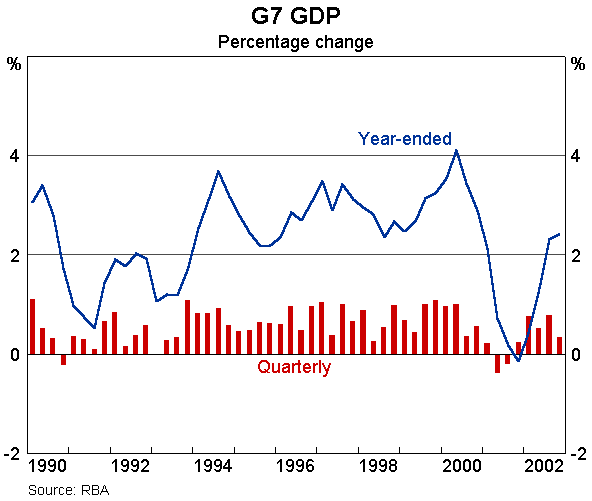
But the important story of the past year is not so much this aggregate pick-up in growth as the changes in momentum that occurred during the course of the year. As we have described in recent quarterly Statements, the last year broadly evolved in two phases. The early and middle part of last year was a period of greater optimism, particularly in the United States, as it became apparent that a recovery was getting under way. This period was characterised by a resumption of growth in output and employment in the US, with apparent spillover effects to other parts of the world as international trade also took on a firmer trend. While growth in Europe generally remained disappointing, Japan and a number of other east Asian economies were strengthening during this period, with a pick-up in exports across the region playing an important role in the overall improvement.
Towards the end of the year, the global recovery began to lose some of that momentum. This was evident in a range of indicators for the US which weakened in the fourth quarter, as well as a general weakening in exports experienced by a number of countries towards the end of the year. Financial markets broadly reflected these shifts in global conditions and, as is often the case, they to some extent anticipated them. Global equity markets declined for much of the second half of 2002 and bond yields fell in all the major international markets, generally reflecting the assessment that prospects for the global economy had deteriorated. To put all this in perspective, however, we need to be clear that the major economies did not go into outright contraction in the final quarter of last year: they continued to grow, but at a much reduced pace.
I have gone to the trouble of outlining that background because it helps us to formulate what seems to be the key question for the global outlook in 2003: what is the nature of the current weak spot in global growth, and how long should it be expected to last? Since we are talking about forecasts, there can be no definitive answer to this, but I will try to make some relevant observations about prospects in two key areas – the US, and non-Japan Asia.
The US economy has been a key driver of the global business cycle and will remain quite central to the prospects for ongoing recovery. Although the US recorded reasonably good growth last year (peaking at an annual rate of 3.3 per cent in the September quarter), the economy is still being affected by some of the imbalances that had earlier pushed it into recession. Of particular note is the low level of business profits and poor financial condition of many US businesses at present. The US economy has also been affected by a substantial overhang of business investment that was built up in the second half of the 1990s. While this now appears to have been largely worked off, some overhang remains in particular sectors, notably in telecommunications. One consequence of all this is that there has been an extended period of contraction in US business investment, though on current indications this decline has now stopped.
On the more positive side, the US household sector has remained quite resilient through the last couple of years. Consumer spending has continued to grow, and low interest rates are promoting an expansion in housing construction activity. It should also be noted that the US economy is receiving considerable policy stimulus. The Fed funds rate has been cut by a total of 525 basis points since early 2001, so that in real terms it has been close to zero or negative for more than a year. At the same time the US government's fiscal position has swung sharply in an expansionary direction. Between 2000 and 2002, the budget moved from a surplus of around 2 per cent of GDP to a deficit of similar size. So there was a net swing of around 4 percentage points, which can be taken as a rough measure of the fiscal position's contribution to growth of the economy. A further package currently under consideration will (if adopted) add further to this stimulus. In some important respects these measures can be expected to have a bigger impact than the counter-cyclical policies that assisted recovery in the early 1990s. The current fiscal stimulus is considerably larger than the one that occurred in the early 1990s. The interest rate reductions in the current episode have not been as large in absolute terms as occurred on the previous occasion, but they were implemented more quickly.
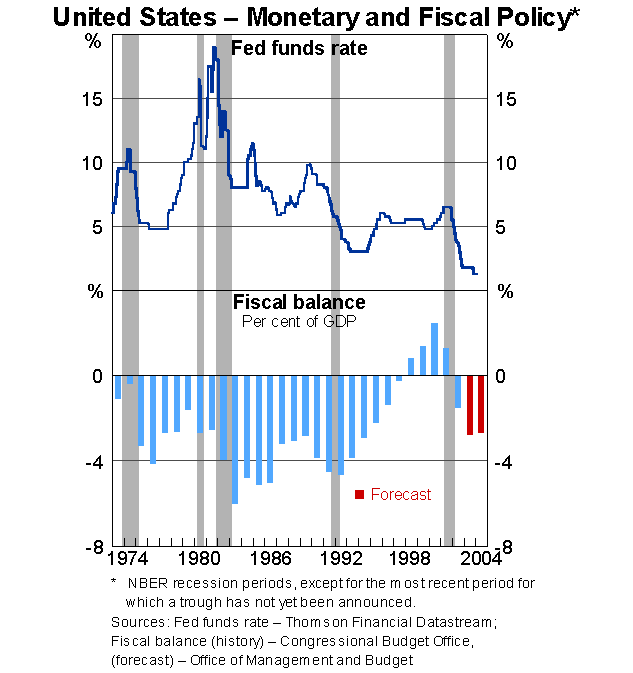
To put the current period in perspective it is also instructive to compare the overall growth performance with the two previous recoveries, in the early 90s and early 80s. Of the two, the current US cycle to date has been much more like the one that occurred in the early 90s, with a relatively shallow trough and a correspondingly modest upturn. In terms of GDP, the current upturn has run slightly ahead of the pace recorded in the early 90s, while the employment paths are almost identical. Another similarity is that the early 90s recovery was for some time quite hesitant and there was lingering scepticism in the early stages as to whether it would be sustained. The same is occurring in the current cycle. At this stage the best guess is for a return to moderate growth, and this is broadly the path that is built into the Consensus forecasts shown in the chart. But there remains a risk that the recent period of weakness will prove to be more prolonged.
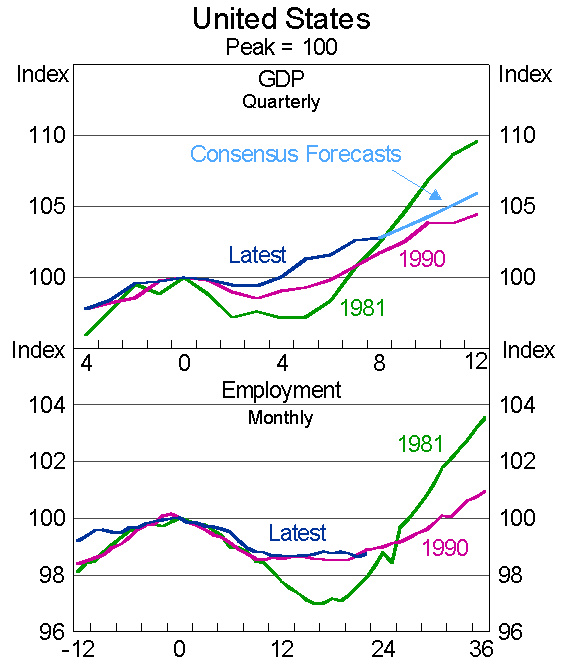
I would also like to make some observations about the non-Japan Asian region, which was a relative bright spot during 2002. While there have been some quite wide disparities in economic performance across individual countries, the region as a whole has been growing strongly, having experienced only a brief pause during 2001. Exports have of course been an important driver of growth, and hence the region benefited from the general improvement in international conditions during much of 2002. But it is interesting to note that in recent years, growth in east Asia has been increasingly sourced from domestic demand. As a result of this, growth held up relatively well during the international downturn in 2001 and, while exports weakened a bit towards the end of last year, the region as a whole continued to perform well.
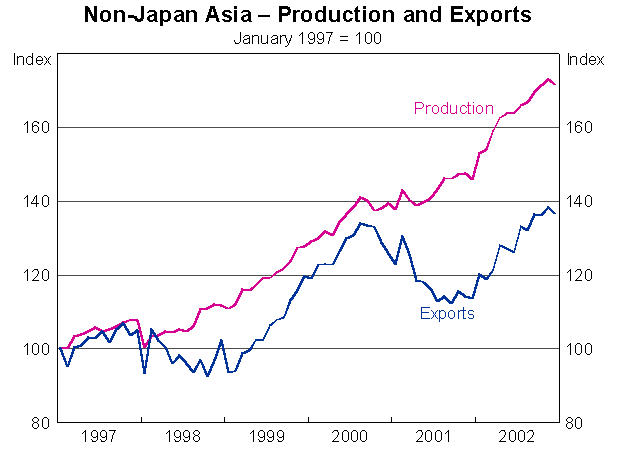
Perhaps the stand-out feature of any review of east Asian economic trends is the rapid growth of the Chinese economy. China has been a consistently strong performer over the past decade, with official GDP figures showing an average growth rate of nearly 10 per cent per annum. Even though these data may be poorly measured, there is no doubt that China's importance in the global economy and in international trade have steadily increased, and will continue to do so for the foreseeable future. Over the 10 years to 2001, for example, China's share in world trade roughly doubled, to just under 5 per cent. Australia seems well placed to benefit from these trends. China has been moderately over-represented in Australia's mix of export destinations, and the growth of Australia's exports to China in recent years has broadly kept pace with the rapid growth in China's overall trade.
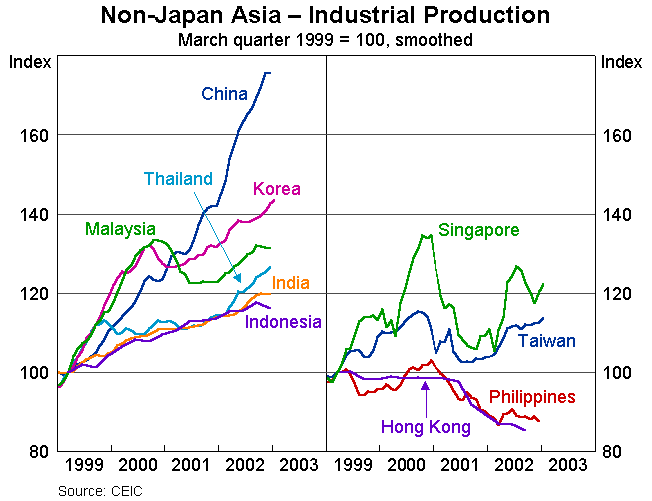
The Australian Economy
Let me turn now to some issues for the domestic economy. In doing so, I will be drawing on the themes presented three weeks ago in our quarterly Statement on Monetary Policy.
The past year has been characterised by rapid growth in domestic demand, partly offset by a strong contractionary effect from the export sector. In reviewing these trends it will be dangerous for me to say too much about precise numbers, since there is a set of new national accounts figures coming out during the course of this speech. Nonetheless the broad outlines are quite clear. Last year, Australia's exports grew only by 2 per cent in real terms, a weak result when set against an average annual growth rate of 8 per cent over the past decade. With imports still growing strongly, net exports overall reduced growth of the economy by more than 3 percentage points over the year. This was the biggest net contractionary effect from this source since the late 1980s. Special factors certainly contributed to this – particularly the drought, the downturn in international tourism and a jump in aircraft imports – but it is also clear that Australia's external sector continued to feel the more general effects of sub-par performance in the global economy.
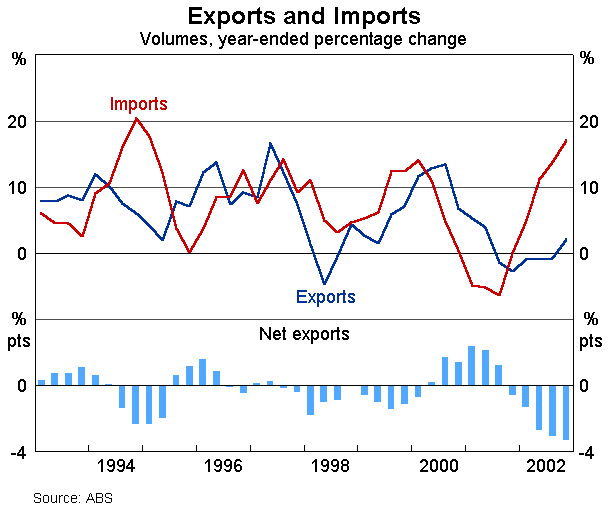
Working in the other direction, domestic demand has been growing rapidly over the past 18 months or so. Consumer spending has been expanding and growth has been supported by the upswing in housing construction and in business investment. The net effect of all this has been that the economy continued to post reasonable growth, though the pace is slowing and the housing construction cycle looks to be nearing a peak.
I will not be giving a detailed set of forecasts but before summing up I want to focus a bit more on two aspects of the domestic economic scene. One is the general condition of the business sector. Throughout the last few years the situation of the Australian business sector has contrasted quite markedly with the one I described earlier for the US. In the main, and despite some high-profile exceptions, profits of Australian businesses in aggregate have remained at a good level by historical standards, and businesses have generally managed their balance sheets quite conservatively. There was substantial de-leveraging in the early 1990s, and aggregate corporate debt has since remained low. One indicator of this is the ratio of corporate interest obligations to profits, which has been close to historical lows throughout the recent period.
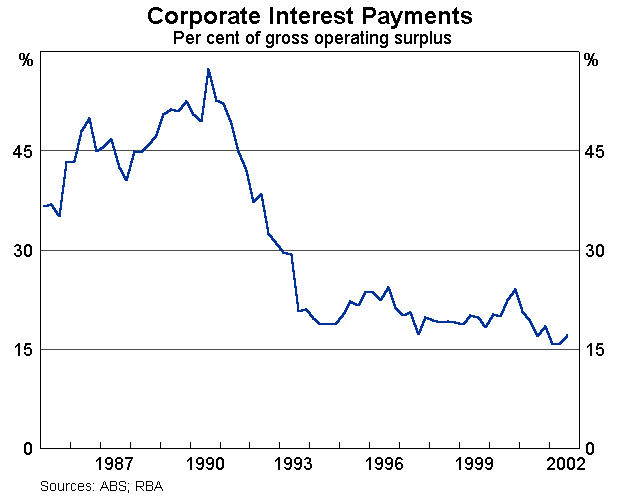
Australian businesses also avoided the sort of investment overhang built up in the US in the late 1990s. With this background, business investment spending entered a solid upswing in 2002, coming off a relatively low base. Conditions still appear broadly supportive of further growth in this area, although outcomes will of course be sensitive to changes in business sentiment and expectations about the international outlook, where there have been some signs of greater caution of late. The latest reading we have on investment plans, from last week's Capex survey, points to further growth, though not as rapid as the exceptional growth seen recently.
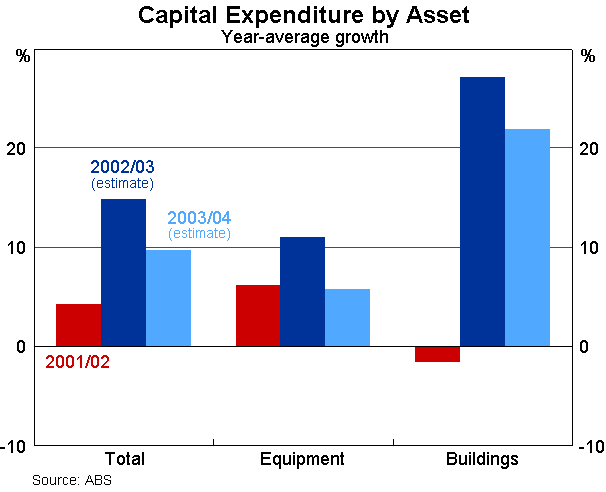
The other area that I will focus on briefly is the rural sector. On latest estimates, the drought conditions of 2002 will have reduced farm production by almost 25 per cent, and this translates into a much larger fall in net farm incomes. The overall effect on the economy has been significant, probably reducing GDP in the current financial year by something approaching 1 per cent. In terms of the fall in production, this makes it the most severe drought since the early 1980s. On some other benchmarks, based on absolute rainfall deficiencies, it is the most severe in a century. It is much too early yet to form a reliable assessment of prospects for the farm sector in 2003/04. Even given improved weather conditions, some of the effects of the drought will linger on for some time. Nonetheless, the historical record suggests that aggregate farm production has the potential to turn around quite quickly, and the recent rains across much of the country do offer the prospect of a better year ahead.
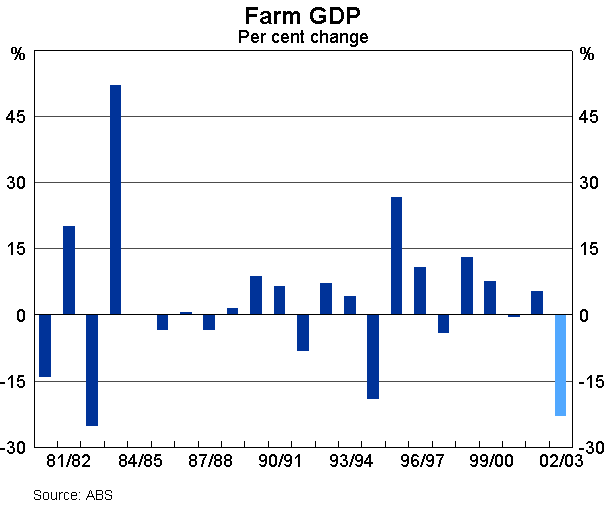
To sum up the general economic situation, I don't think I can do better than re-state the main themes expressed in our recent Statement on Monetary Policy. The international environment is quite an uncertain one, and the outlook now is not as promising as it seemed to be at this time last year. Most observers still expect a gradual pick-up later in the year, but that would still mean a further period of sub-par growth in the major economies. In Australia these effects have, to date, been largely offset by the strength of domestic demand. But looking ahead, some rebalancing of growth is expected, with domestic demand slowing and the drag from net exports being gradually wound back; this is likely to mean the overall pace of growth being a bit slower than we have been accustomed to recently. Even so, Australia still seems well-positioned to perform relatively well in what is a fairly difficult international environment.